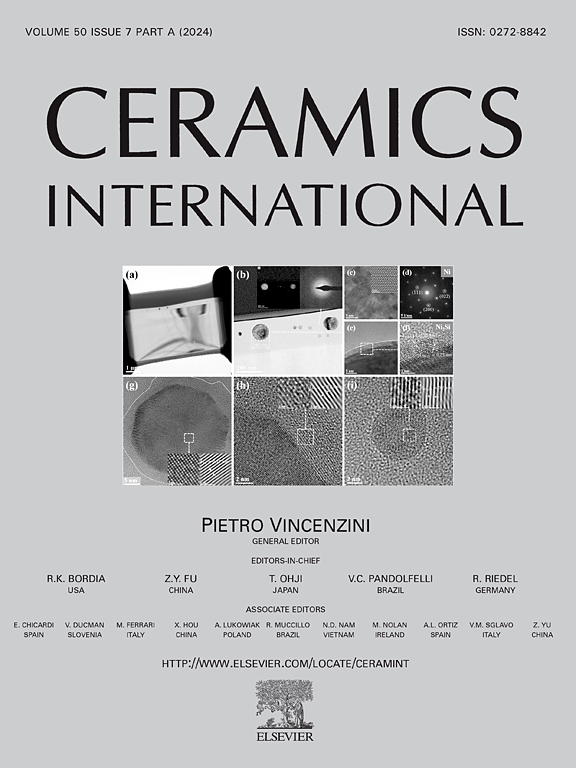Preparation and properties of Al2O3-SiC-C refractories using recycled Al2O3-C composite slide plates materials
IF 5.6
2区 材料科学
Q1 MATERIALS SCIENCE, CERAMICS
引用次数: 0
Abstract
The short service life of existing slide plates led to significant waste of high-quality raw materials. Recycling these materials into appropriate refractories with less demanding conditions can reduce costs and extend their service life. In this study, recycled Al2O3-C composite slide plates materials (RACM) were used to prepare Al2O3-SiC-C (ASC) refractories. The influence of RACM addition on phase compositions, microstructure and properties of ASC refractories were investigated. The results showed that: The RACM promoted the formation and growth of SiC whiskers in ASC refractories, enhancing the ability of ASC refractories to resist elastic deformation and the fracture propagation. Meanwhile, the progress of reaction sintering enhanced the interface binding between aggregates and improved the consistency of the oxidation interface. The oxidation resistance behavior of ASC refractories was enhanced 6.7 % with 32 wt% RACM addition. The physical properties and oxidation resistance properties of the ASC refractories with 32 wt% RACM were the best, and could meet the performance requirements for hot metal pretreatment.
利用再生Al2O3-C复合滑板材料制备Al2O3-SiC-C耐火材料及其性能
现有滑板使用寿命短,造成优质原材料的大量浪费。将这些材料回收成要求较低的耐火材料,可以降低成本并延长其使用寿命。本研究采用再生Al2O3-C复合滑板材料(RACM)制备Al2O3-SiC-C (ASC)耐火材料。研究了添加RACM对ASC耐火材料相组成、显微组织和性能的影响。结果表明:RACM促进了ASC耐火材料中SiC晶须的形成和生长,增强了ASC耐火材料抗弹性变形和断裂扩展的能力;同时,反应烧结的进展增强了团聚体之间的界面结合,提高了氧化界面的一致性。添加32%的RACM, ASC耐火材料的抗氧化性能提高了6.7%。含32 wt% RACM的ASC耐火材料的物理性能和抗氧化性能最好,可以满足铁水预处理的性能要求。
本文章由计算机程序翻译,如有差异,请以英文原文为准。
求助全文
约1分钟内获得全文
求助全文
来源期刊

Ceramics International
工程技术-材料科学:硅酸盐
CiteScore
9.40
自引率
15.40%
发文量
4558
审稿时长
25 days
期刊介绍:
Ceramics International covers the science of advanced ceramic materials. The journal encourages contributions that demonstrate how an understanding of the basic chemical and physical phenomena may direct materials design and stimulate ideas for new or improved processing techniques, in order to obtain materials with desired structural features and properties.
Ceramics International covers oxide and non-oxide ceramics, functional glasses, glass ceramics, amorphous inorganic non-metallic materials (and their combinations with metal and organic materials), in the form of particulates, dense or porous bodies, thin/thick films and laminated, graded and composite structures. Process related topics such as ceramic-ceramic joints or joining ceramics with dissimilar materials, as well as surface finishing and conditioning are also covered. Besides traditional processing techniques, manufacturing routes of interest include innovative procedures benefiting from externally applied stresses, electromagnetic fields and energetic beams, as well as top-down and self-assembly nanotechnology approaches. In addition, the journal welcomes submissions on bio-inspired and bio-enabled materials designs, experimentally validated multi scale modelling and simulation for materials design, and the use of the most advanced chemical and physical characterization techniques of structure, properties and behaviour.
Technologically relevant low-dimensional systems are a particular focus of Ceramics International. These include 0, 1 and 2-D nanomaterials (also covering CNTs, graphene and related materials, and diamond-like carbons), their nanocomposites, as well as nano-hybrids and hierarchical multifunctional nanostructures that might integrate molecular, biological and electronic components.
 求助内容:
求助内容: 应助结果提醒方式:
应助结果提醒方式:


